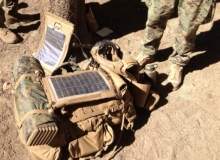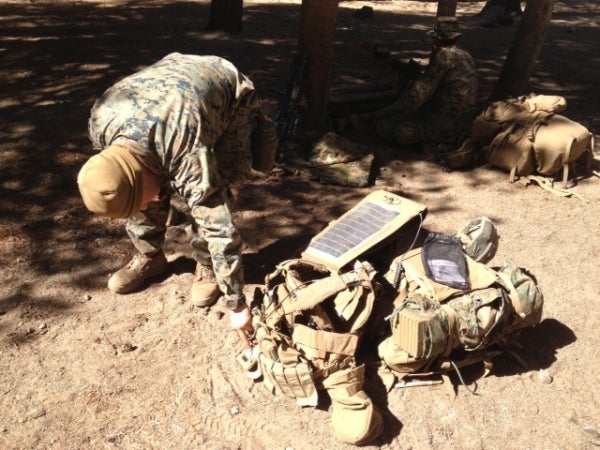

It is one of the greatest challenges of our time, contending with the effects of climate change and tackling the problem of finite natural resources. Governments, companies and individuals are becoming ever more conscious about the use of energy – especially how much that energy costs in terms of money and environmental damage.
Militaries globally are trying to reduce their energy consumption and concentrate more on renewable technologies. According to the Department of Defense (DoD), the US military consumed an estimated $16.4bn worth of liquid fuel in 2012. This is expected to increase to $17bn this year.
More than half of US military’s liquid fuels are also purchased outside of the US. These symbiotic constraints of cost and availability of natural resources are concerning many planners, not only in the US, but also other nations with large defence forces, such as the UK and Australia.
To address energy use in the US forces, the DoD published its Operational Energy Strategy in 2011. The US military hopes that, by using renewable energy, future capabilities will have maximum versatility, which in-turn will make the military more adaptable and agile.
Recent projects have looked to introduce photovoltaic solar cells onto the soldier’s personal kit and uniform. Cells integrated onto backpacks and helmets have frequently been cited as one method of increasing a soldier’s capability on the field. Significant progress has been made in this field, but challenges remain.
How well do you really know your competitors?
Access the most comprehensive Company Profiles on the market, powered by GlobalData. Save hours of research. Gain competitive edge.

Thank you!
Your download email will arrive shortly
Not ready to buy yet? Download a free sample
We are confident about the unique quality of our Company Profiles. However, we want you to make the most beneficial decision for your business, so we offer a free sample that you can download by submitting the below form
By GlobalDataThe benefits of wearable solar technology
With batteries powered by solar energy, experts say, you can shed a significant amount of weight a soldier carries simply because they do not need to carry a large number of spare batteries.
"Modern foot soldiers increasingly rely on electrical power; however, batteries and other energy storage systems offer limited capabilities," explains Igor Skryabin, a business development manager at the Australian National University’s Centre for Sustainable Energy Systems (CSES). "Harvesting energy from the environment is a viable option, and no other form of energy has the harvesting potential matching that of solar."
CSES has worked with Australia’s Defence Science and Technology Organisation (DSTO) to develop SLIVER solar cell modules for military use. These are extremely thin and flexible solar cells which have high power-to-weight ratios and can be conformed to complex surfaces such as helmets. Improved modules will be demonstrated to the Australian DoD in early 2014.
One complaint Skryabin makes about the development of wearable solar technology is the lack of international cooperation. "Research programmes in different countries are disjoined and, naturally, the progress is not as fast as in the fields that bring together international expertise. More collaboration will certainly accelerate progress in wearable solar," he adds.
‘Little justification’ for wearable technology?
In 2011, the UK’s Defence Science and Technology Laboratory (Dstl) unveiled its own wearable solar initiative called ‘Solar Soldier’. In collaboration with a number of UK universities, the project looked to use a combination of wearable solar photovoltaic cells and thermoelectric devices to provide a ’round-the-clock’ power supply for soldiers.
The Solar Soldier project finished in December 2011 and since then the UK Ministry of Defence has been notably quiet in this area. Dstl tells Army-technology.com that one of the key aims of the project was to assess the benefits offered by solar, while also identifying drawbacks.
"In some instances, the benefits of a solar panel can be outweighed by the associated weight of the cables and the charger needed to channel the energy captured into one of the soldier’s batteries, especially if the soldier is on a short mission during which there is little time to harness much energy," a Dstl spokesman explains.
"For long missions and in sunny conditions, benefits are offered for non-critical equipment," he continues. "But with current performance levels there is little justification for reducing the number of spare batteries required for mission critical equipment. There is a good likelihood that aspects of this technology will improve in the future and could find greater utility in future soldier systems."
MAPS: a US-led wearable solar initiative
It is this capability to harvest energy on longer missions and in sunnier climates that could be useful to an infantry force like the US Marines Corps. Marines often patrol for weeks, rather than days, without any ability to recharge batteries for radios and other equipment. This means they carry an enormous amount of kit, sometimes weighing as much as 70kg.
This amount of kit is needed because commanders have to be sure they have enough redundancy equipment in case of emergencies or changes to a mission – the so-called ‘safety factor’.
"When you do not have the ability to harvest energy in any capacity you end up using a safety factor in your planning," says Captain Frank Furman, a US Marine Corps infantry officer with two operational tours of Afghanistan under his belt. "Instead of taking four batteries maybe I’ll bring six or maybe I’ll bring eight, because that will give me the feeling of security that I need that I will never run out entirely."
Captain Furman is now a logistics programme manager at the Office for Naval Research’s (ONR) Expeditionary Maneuver Warfare and Combating Terrorism Department based in Arlington, Virginia. He is using his knowledge and insight as a marine officer, along with his graduate education in applied physics, to develop a new generation of wearable solar equipment called Marine Austere Patrolling System (MAPS).
MAPS includes a ruggedised and flexible solar panel which has around 30% efficiency and is only the size of a sheet of paper. In October, marines from the 1st Battalion 5th Marines used MAPS during a field test at the Mountain Warfare Training Center in California.
Overcoming wearable solar challenges in an age of austerity
Furman says the marines were quick to adapt to the new technology. "Feedback was overall very positive; they got good performance from the solar panels and were able to reduce their battery needs. In fact, of the units that were trying it out the only one that needed a battery resupply was the one unit which had some faulty batteries."
The marine officer admits it is a challenging environment for the development of wearable solar, which means progress will continue to be incremental, rather than revolutionary. The cuts in defence budgets, and especially in research and development funds, also means more militaries are concentrating on mission-critical technologies that only the military require.
"There isn’t much of an appetite for the military to invest too much in this area because, one, private industry is advancing state-of-the art solar incrementally year by year and, two, our operations are winding down in Afghanistan and there is some uncertainty about where we will be operating next."
So is there a time when the US military will order thousands of units of wearable solar? "We’re definitely getting there but we’re not there yet," says Furman. "I would suspect that you’re going to see some niche applications with, say, Special Forces over the next couple of years and, in fact, you already are to some extent. But in terms of widespread adoption, I think we’re probably still ten years away from seeing it across the board."
Taking cues from commercially-driven solar innovation
With the military re-focusing resources away from non-critical development, we may be entering an era where innovation in wearable solar is driven more and more by the commercial sector and academic institutions. This is already apparent in large-scale solar development for static facilities.
One example of this commercial drive is the ‘Wearable Solar’ project in the Netherlands, led by Christiaan Holland of Dutch agency Gelderland Valoriseert and assisted by students at the University of Applied Sciences in Nijmegen. In June 2013 Holland unveiled a dress and coat prototype with integrated solar cells for everyday wear. The clothes are designed by Pauline van Dongen and the solar panels are the work of specialist Dr Gert Jan Jongerdan.
The design of the coat includes flaps embedded with flexible solar cells which can be unfolded when the sun is shining.
"The prototypes worked well," says Jan Jongerden, an expert on wearable solar and energy storage. "Our main goal was to come up with solutions that would be wearable to charge your cell phone within an hour. We wanted to have a good balance between, of course, affordability, but also comfort, wearability and output performance."
The project has involved testing both rigid wafer technologies, normally found on larger solar panels, and flexible thin-film cells. Jan Jongerden says both technologies work well, with amorphous silicon being more desirable for comfort but lacking in power output.
Boom or bust for wearable solar?
As for a boom in demand for wearable solar in the commercial sector, Jan Jongerden isn’t expecting a rapid breakthrough. "The market outside the military is still weak. The military is still the most important sector and in my experience they are mostly developing dedicated projects for specific soldier applications."
Despite slow progress, interest in wearable solar technology in both the commercial and military world continues.
For the military, the technology’s reliability must be rock-solid as it would be powering critical gear like radios and navigation equipment, which are vital to a soldier’s survival. For wearable solar to be a standard piece of kit there needs to be a perfect combination of low costs, high demand and overall utility, all of which has yet to be realised.
Follow Grant Turnbull on Google+
Related content
The future for armoured vehicle technology
The variety of models currently out for tender demonstrates a lack of consensus on future vehicle designs, especially in key areas such as mobility and protection.
Lightning strikes – Is the F-35 great for Britain?
From its Joint Strike Fighter origins, the F-35 programme has been plagued by technical hitches, delays and cancelled orders.


.gif)

